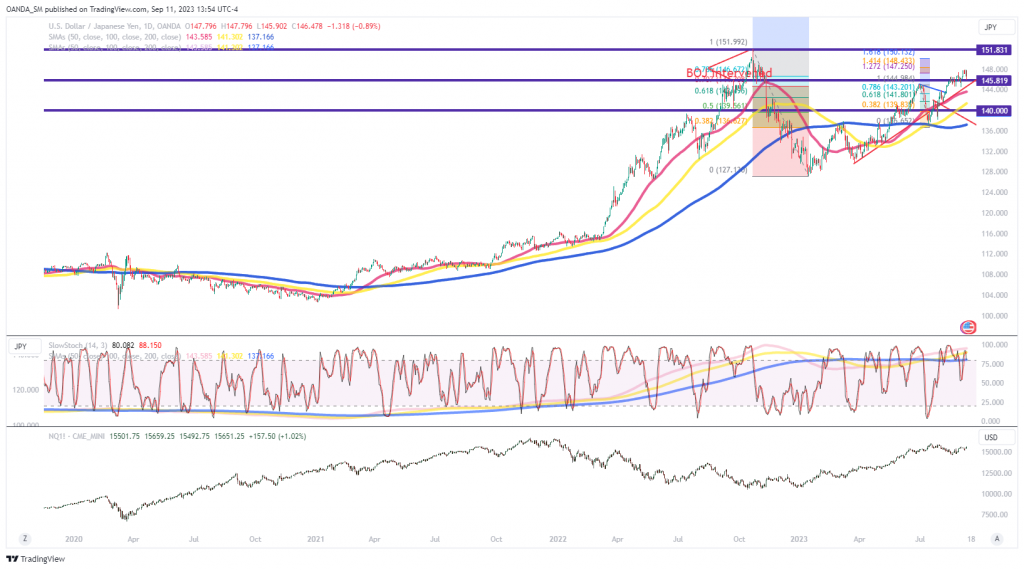- Post-BOJ Initial reaction – yen jumped, dollar fell, gold rallied, and equities rose. Some of these moves have started to reverse
- Japan’s Overnight Swap Indexes have an implied rate of 0.042% by the January 23rd BOJ policy meeting
- US 3-year Treasury attracts highest yield since 2007 (4.660% vs 4.650% pre-sale)
The Japanese yen surged in Asia following BOJ Governor Ueda’s verbal intervention. Ueda noted that the BOJ might know enough about wage pressures by year-end, in other words if they could be ready to abandon negative rates. The BOJ blackout period typically starts two days before the first policy meeting, which means we could have a full week of verbal intervention before the September 21st policy meeting starts. Japan officials will likely hesitate to actually intervene until some of the major US risk events are behind us. No sense in selling dollars before seeing the latest US inflation report, which could easily upend any action.
A new week is here, and it looks like financial markets were ready for a major reset. Dollar-yen bearishness could also gain momentum if risk appetite deteriorates here. The yen got a boost after some weekend reading reaffirmed Wall Street’s belief that the Fed will pause rate increases in September, then review the latest economic data and assess if more rate hikes are needed in November/December. The WSJ’s Nick Timiraos, who’s also known as the Fed whisperer has markets convinced that officials view the risks as more balanced, so a September surprise is very unlikely. It seems many risk events are on this week’s calendar, so we could see other drivers besides more chatter from Japanese officials and US CPI/retail sales data/inflation expectations. The
$AAPL
This will be a big week for tech given the recent slide with some of the mega-cap tech stocks. Apple was in the headlines after they decided to stick with Qualcomm’s 5G modems for their smartphones. Apple was trying to produce similar chips as soon as 2024, but it seems they aren’t there just yet. The Qualcomm deal for Snapdragon 5G Modem-RF Systems will cover smartphone launches in 2024, 2025 and 2026. This is great news for Qualcomm shares, while Apple shares will mostly await what happens with Tuesday’s important launch event. Expectations are for Apple to unveil the new iPhone 15 and show how AI will be used.
$TSLA
Tesla is also getting a boost after Morgan Stanley upgraded the EV giant and raised their price target from $250 to a street-high $400 a share. The upgrade was driven by hopes that their Dojo supercomputer could help accelerate the adoption of robotaxis and network services.
Equities and risk appetite will have a handful of events to determine if a rebound is justified: Tuesday is all about the Apple event. Wednesday focuses on the US inflation report, which should show rising gasoline prices sent headline inflation higher, but the core readings are likely to remain subdued. Thursday will be busy with the UAW strike deadline, a potential pause by the ECB, slight labor weakness from jobless claims data, and a soft retail sales report. For Wall Street, Thursday’s focus should fall on the UAW strike deadline, which falls a minute before midnight. A potential UAW strike of 10 days could trigger a recession for the Michigan economy and cost $5.6 billion in US GDP. Friday contains the release of the University of Michigan inflation expectations, which are important for the higher for longer trade.
Any yen strength could be short-lived until we get beyond some of the big market events of the week.
USD/JPY Daily Chart
Bearish price on USD/JPY , a daily chart of which is shown, is tentatively respecting key trendline support that started from the July 28th low. The knee-jerk selloff spurred from BOJ Governor Ueda’s verbal intervention might not be the beginning of a new trend just yet. Given the state of the US economy and its resilience, it appears that Japan’s central bank remains very concerned with the yen’s levels. If USD dollar strength reemerges, the 147.80 level remains critical resistance. On the other hand, if risk aversion runs wild, the 145.00 level provides initial support, followed by the 143.75 level.
Content is for general information purposes only. It is not investment advice or a solution to buy or sell securities. Opinions are the authors; not necessarily that of OANDA Business Information & Services, Inc. or any of its affiliates, subsidiaries, officers or directors. If you would like to reproduce or redistribute any of the content found on MarketPulse, an award winning forex, commodities and global indices analysis and news site service produced by OANDA Business Information & Services, Inc., please access the RSS feed or contact us at info@marketpulse.com. Visit https://www.marketpulse.com/ to find out more about the beat of the global markets. © 2023 OANDA Business Information & Services Inc.




